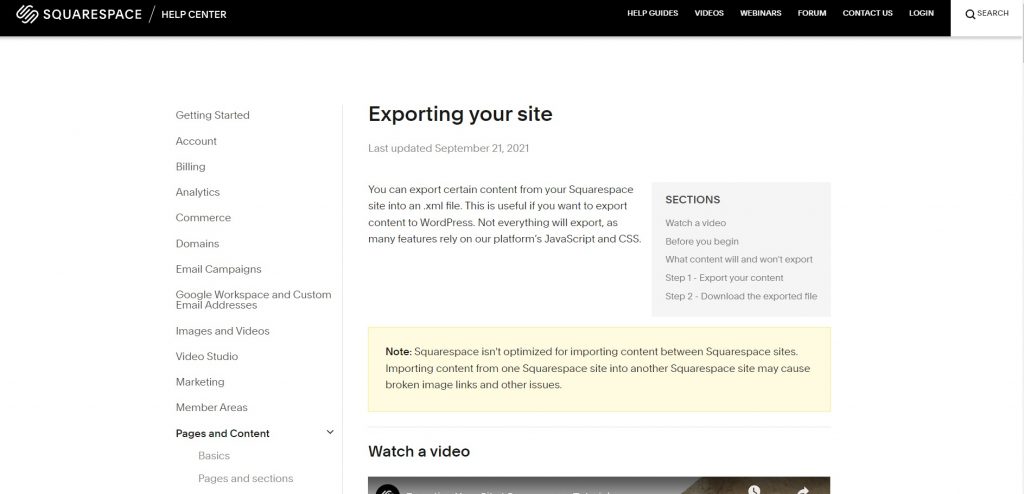Unfortunately, the rapid development of technologies and the improvement of information protection methods don’t make anyone safe from data loss.
Fortunately, the vast majority of website builders include the data loss prevention functionality and the hero of today’s review isn’t an exception.
Squarespace offers powerful 256-bit encryption and provides constant analysis of system failures. Also, your information is stored in multiple Tier data centers of the 3-rd security level (out of 4 possible).
These data centers offer an uptime of 99.982% (it means about 1.6 hours of downtime annually). Also, they have a network of backup power supply and cooling systems.
Even so, there still are the chances of data loss if your hosting is down, that’s why doing a backup for your Squarespace-based website could be a good idea.
Let’s find out how to do it in the most efficient way.
Also, I offer you to take a look at the following articles to know more about Squarespace service.
Squarespace description:
Squarespace Review & Pricing [2021]
Best Squarespace templates for podcasting
How to add AdSense to Squarespace
How to add favicon to Squarespace
How to embed PDF into Squarespace
Methods to add a responsive table to Squarespace site
Squarespace comparisons:
Top 3 solutions
XML file downloading
An XML file that contains tags (which use syntaxis to structure information) and text content (surrounded by tags) is used for 3 main purposes: structuring, storing and transferring the information.
To get this file, you need to go to the home menu and click on “Settings”. Then, choose “Advanced settings”, click on “Import/Export”, and then on the “WordPress” icon.
Keep in mind that WordPress is the only available option. Even if you’re not going to transfer the information on that platform, you need to click on it anyway.
It’ll take a few minutes to complete the export (it depends on the amount of content and the number of pages of your website).

When the process is completed, you can click on “Download” and get an XML file.
Now, let’s take a look at content that can be transferred using an XML file.
You can transfer the following:
- template and blog pages;
- text and image blocks;
- gallery and project pages, etc.
You can’t transport the following:
- folders;
- product blocks;
- audio and video blocks.
You can find the full list of items in the Squarespace Help Center.
If you’re versatile in coding to have injected CSS code into your web pages, this content won’t be transported as well. You can simply store CSS files on your computer or cloud storage services to fix this issue.
If you sell products, they won’t be added to the XML file as well. In this case, you can use a CSV file but it doesn’t guarantee that all your items will be imported cleanly. However, you’ll have raw data to work with.
To get the product CSV file, you need to go to the “Commerce” menu, choose “Inventory”, and find the “Export all” option.
If you need to restore the style settings, which you’ve erased or edited, you need to download a JSON file in the “Design” menu: choose “Site Styles” and find the “Export” button.
For your convenience, you can set notifications about the need for recovery quarterly using the calendar and reminders. This is exactly the way I do.
Visual sitemap building
This method is even easier than the previous one and will take you a few minutes. A visual sitemap building is a handy way to describe the relationship between different pages of your website and get a scheme of the content organization, navigation, and so on.
This method also requires you to have an XML file that you need to upload to one of the visual sitemap builders. Currently, you can find a lot of such platforms on the web: Lucidchart, Bubble, Slickplan, etc. These services offer a fully customizable process of visual sitemap building: you can add pages attributes, work with styles, organize real-time co-authoring, and many more.
Let’s take a look at the algorithm for creating a visual sitemap using the Slickplan service as an example.

First of all, you need to create an account, log in, and choose the “Create new sitemap” option. Then, you need to pick the name for your project, and click on “Create”. After that, you’ll be offered either to paste your website’s link or upload an XML file. Then, click on “Import” and wait a couple of minutes till the process is finished. After that, you can see a visual layout of your website that is easy to look at and analyze.
Website content saving
This method isn’t as advanced as previous ones and requires more time in case you don’t use cloud services such as Google Docs to create your content. In turn, you don’t need to use third-party services.
All you need to do is to take all content of each web page (text, media files, links, etc.) and upload it to the external hard disks, your personal computer, or cloud storage services. Also, I’d recommend making notes in documents about the date of the last content editing.
FAQ
Is there a platform that is compatible with Squarespace and can be used for the export website?
Yes, Squarespace recommends WordPress.
Is it possible to use an XML file to transport information between 2 Squarespace websites?
No, this option is unavailable.
Can I export linked PDF files from Squarespace to XML files?
Yes, this option is available.
Does Squarespace support auto backup?
No, this feature is currently unavailable.
